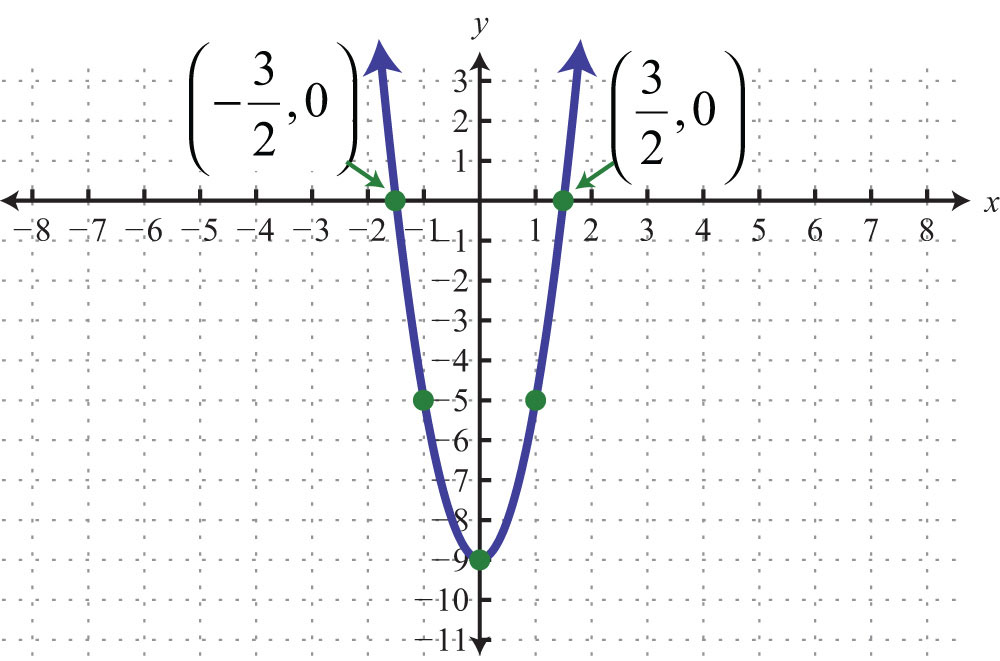This is “Review Exercises and Sample Exam”, section 9.7 from the book Beginning Algebra (v. 1.0). For details on it (including licensing), click here.
For more information on the source of this book, or why it is available for free, please see the project's home page. You can browse or download additional books there. To download a .zip file containing this book to use offline, simply click here.
9.7 Review Exercises and Sample Exam
Review Exercises
Extracting Square Roots
Solve by extracting the roots.
1.
2.
3.
4.
5.
6.
7.
8.
9.
10.
11.
12.
Find a quadratic equation in standard form with the given solutions.
13.
14.
Completing the Square
Complete the square.
15.
16.
Solve by completing the square.
17.
18.
19.
20.
21.
22.
23.
24.
25.
26.
27.
28.
29.
30.
Quadratic Formula
Identify the coefficients a, b, and c used in the quadratic formula. Do not solve.
31.
32.
33.
34.
Use the quadratic formula to solve the following.
35.
36.
37.
38.
39.
40.
41.
42.
43.
44.
45.
46.
Guidelines for Solving Quadratic Equations and Applications
Use the discriminant to determine the number and type of solutions.
47.
48.
49.
50.
Solve using any method.
51.
52.
53.
54.
55.
56.
57.
58.
59.
60.
61.
62.
Set up an algebraic equation and use it to solve the following.
63. The length of a rectangle is 2 inches less than twice the width. If the area measures 25 square inches, then find the dimensions of the rectangle. Round off to the nearest hundredth.
64. An 18-foot ladder leaning against a building reaches a height of 17 feet. How far is the base of the ladder from the wall? Round to the nearest tenth of a foot.
65. The value in dollars of a new car is modeled by the function , where t represents the number of years since it was purchased. Determine the age of the car when its value is $22,000.
66. The height in feet reached by a baseball tossed upward at a speed of 48 feet/second from the ground is given by the function , where t represents time in seconds. At what time will the baseball reach a height of 16 feet?
Graphing Parabolas
Determine the x- and y-intercepts.
67.
68.
69.
70.
Find the vertex and the line of symmetry.
71.
72.
73.
74.
Graph. Find the vertex and the y-intercept. In addition, find the x-intercepts if they exist.
75.
76.
77.
78.
79.
80.
81.
82.
Determine the maximum or minimum y-value.
83.
84.
85.
86.
87. The value in dollars of a new car is modeled by the function , where t represents the number of years since it was purchased. Determine the age of the car when its value is at a minimum.
88. The height in feet reached by a baseball tossed upward at a speed of 48 feet/second from the ground is given by the function , where t represents time in seconds. What is the maximum height of the baseball?
Introduction to Complex Numbers and Complex Solutions
Rewrite in terms of i.
89.
90.
91.
92.
Perform the operations.
93.
94.
95.
96.
Solve.
97.
98.
99.
100.
101.
102.
Sample Exam
Solve by extracting the roots.
1.
2.
Solve by completing the square.
3.
4.
Solve using the quadratic formula.
5.
6.
Solve using any method.
7.
8.
9.
10.
Set up an algebraic equation and solve.
11. The length of a rectangle is twice its width. If the diagonal measures centimeters, then find the dimensions of the rectangle.
12. The height in feet reached by a model rocket launched from a platform is given by the function , where t represents time in seconds after launch. At what time will the rocket reach 451 feet?
Graph. Find the vertex and the y-intercept. In addition, find the x-intercepts if they exist.
13.
14.
15.
16.
17. Determine the maximum or minimum y-value: .
18. Determine the x- and y-intercepts: .
19. Determine the domain and range: .
20. The height in feet reached by a model rocket launched from a platform is given by the function , where t represents time in seconds after launch. What is the maximum height attained by the rocket.
21. A bicycle manufacturing company has determined that the weekly revenue in dollars can be modeled by the formula , where n represents the number of bicycles produced and sold. How many bicycles does the company have to produce and sell in order to maximize revenue?
22. Rewrite in terms of i: .
23. Divide: .
Solve.
24.
25.
Review Exercises Answers
1: ±16
3:
5:
7: 2, 8
9:
11:
13:
15:
17:
19:
21:
23: −3/2, 1
25:
27:
29:
31: , , and
33: , , and
35:
37:
39:
41:
43: −12, 24
45:
47: Two real solutions
49: One real solution
51: −10, 6
53: ±1/5
55:
57:
59: −4, 3
61:
63: Length: 6.14 inches; width: 4.07 inches
65: It is worth $22,000 new and when it is 24 years old.
67: x-intercepts: (−3, 0), (1/2, 0); y-intercept: (0, −3)
69: x-intercepts: none; y-intercept: (0, 2)
71: Vertex: (3, −8); line of symmetry:
73: Vertex: (−3/2, −13/4); line of symmetry:
75:

77:

79:

81:

83: Minimum: y = −24
85: Maximum: y = 9/5
87: The car will have a minimum value 12 years after it is purchased.
89:
91:
93:
95:
97:
99:
101:
Sample Exam Answers
1:
3:
5: −1, 3/2
7: −6/5, 0
9: −2, −1
11: Length: 12 centimeters; width: 6 centimeters
13:

15:

17: Maximum: y = −3
19: Domain: R; range:
21: To maximize revenue, the company needs to produce and sell 100 bicycles a week.
23:
25:




